
Introduction
Welcome to the August 2022 Apartment List National Rent Report. Our national index rose by 1.1 percent over the course of July, a slightly slower rate of growth than we observed last month. So far this year, rents are growing more slowly than they did in 2021, but faster than they did in the years immediately preceding the pandemic. Over the first seven months of 2022, rents have increased by a total of 6.7 percent, compared to an increase of 12.0 percent over the same months of 2021. Year-over-year rent growth currently stands at 12.3 percent, but has been trending down since the start of the year from a peak of 18 percent.
On the supply side, our national vacancy index held steady at 5 percent this month. Our vacancy index has been gradually easing from a low of 4.1 percent last fall, but that easing now appears to be leveling off at a rate that remains well below the pre-pandemic norm. This may be at least partially attributable to spiking mortgage rates, which can contribute to tightness in the rental market by sidelining potential first-time homebuyers from the for-sale market and keeping these households in rental units for longer. Rents increased this month in 87 of the nation’s 100 largest cities. The Miami metro has seen the nation’s fastest rent growth over the past year, but elsewhere in the Sun Belt, the booming Phoenix and Las Vegas markets have shown signs of cooling in recent months.
Month-over-month rent growth cools slightly with 1.1% increase; rents up 12.3% year-over-year
The national median rent increased by a record-setting 17.6 percent over the course of 2021. This rapid growth in rent prices is a key contributor to overall inflation, which is currently rising at its fastest pace in 40 years.1 With inflation top-of-mind for policymakers and everyday Americans alike, our rent index is particularly relevant, since movements in market rents lead movements in average rents paid. As a result, our index can signal what is likely ahead for the housing component of the official inflation estimates produced by the Bureau of Labor Statistics. Thankfully for the country’s renters, our index shows that rent growth in 2022 has cooled from last summer’s peaks. At the same time, however, rents are continuing to rise faster than they did in pre-pandemic years.
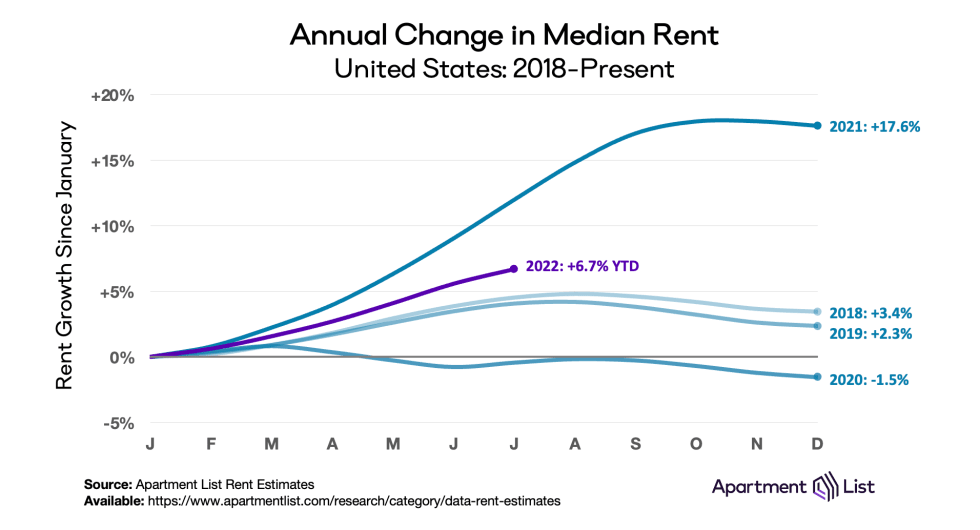
In the seven months of this year, our national rent index has increased by 6.7 percent, well below last year’s 12.0 percent increase over the same months. However, this year’s pace is also still notably faster than that of the years prior to 2021. For comparison, rent growth from January to July totalled 4.0 percent in 2017, 4.5 percent in 2018, 4.1 percent in 2019, and -0.4 percent in 2020. Rent growth is pacing well behind last summer’s scorching pace, but ahead of the pre-pandemic norm, as can also be seen in the following chart of month-over-month growth from 2018 to present.

Our national rent index increased by 1.1 percent month-over-month in July, representing a slight cooldown from last month’s 1.4 percent increase. In July 2021, our national rent index logged record-setting month-over-month growth of 2.7 percent, more than doubling this month’s increase. In contrast, from 2017 to 2019, month-over-month growth in July averaged 0.6 percent, just over half of this month’s increase. Over the past 12 months as a whole, rent prices have spiked by a staggering 12.3 percent nationally. That said, our year-over-year growth estimate has been gradually cooling in recent months after peaking at 18 percent last December, as monthly growth comes in slower than last year’s pace. This month’s slowing rate of growth is consistent with the timing of seasonal trends that we have observed in the past, and it is likely that growth will cool further in the coming months, as the fall and winter tend to bring a slowdown in rental market activity.
Vacancy rate easing appears to be leveling off
As we’ve explored in detail, much of the 2021 rent boom was attributable to a tight market in which more households were competing for fewer vacant units. Our vacancy index spiked above 7 percent in the early months of the pandemic in 2020, as many Americans consolidated households and moved in with family amid the uncertainty and economic disruption of the pandemic’s onset. After that, however, rapid household formation chipped away at the vacancy rate, eventually falling to a low of 4.1 percent.
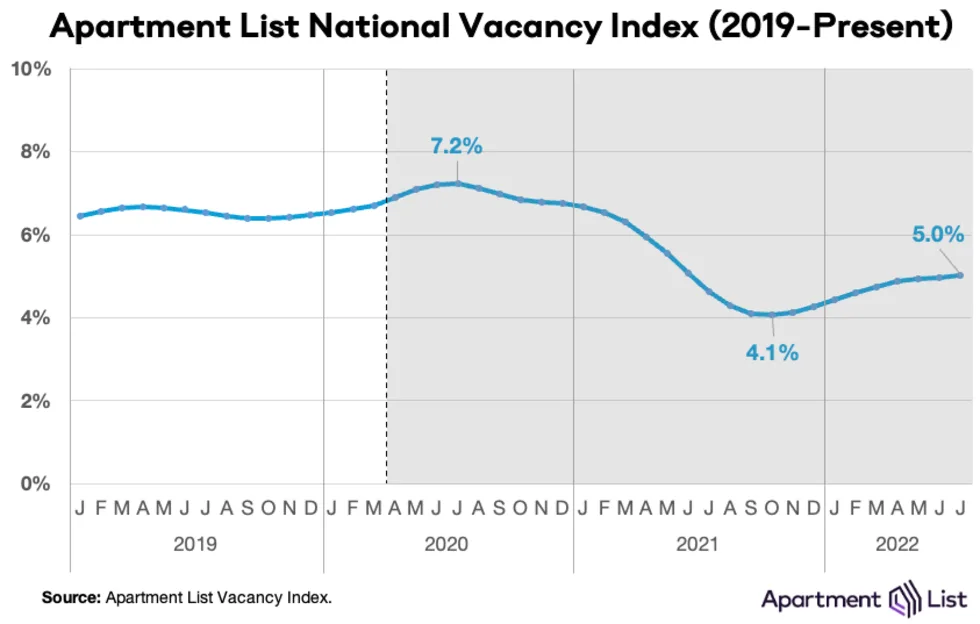
After bottoming out at 4.1 percent last October, our vacancy index has been on a trend of gradual easing. This month however, our index remained flat at 5 percent for the third consecutive month, following seven consecutive months of increases. It’s likely that spiking mortgage rates are beginning to sideline potential first-time homebuyers from the for-sale market, keeping these households in rental units for longer. And although we’re now in the midst of the busy season for the rental market, when the bulk of moving activity normally takes place, rapidly rising rents may be incentivizing many renters to stay put and renew existing leases rather than looking for new ones. These factors could be contributing to the flattening of our vacancy index at a level that is still far below the pre-pandemic norm.
Vacancy trends are highly localized, and they played a major role in determining how quickly rent inflation affected cities throughout the pandemic. To explore the topic in greater detail, monthly vacancy data are now available for download for hundreds of cities, metros, and states, and can be easily linked to our existing rent estimates.
Rents up month-over-month in 87 of 100 largest cities
The chart below visualizes monthly rent changes in each of the nation’s 100 largest cities from January 2019 to present. The color in each cell represents the extent to which prices went up (red) or down (blue) in a given city in a given month. In 2020, we can see that rents fell sharply in many of the nation’s largest and most expensive cities, while smaller and more affordable ones picked up steam, leading to some convergence in prices. Meanwhile, the dark red band in 2021 depicts last year’s rent heatwave, which peaked in July and August 2021 when all 100 cities in this chart saw prices go up. The rightmost columns show that virtually across the board, rent growth remains positive but has cooled significantly from last year’s pace.
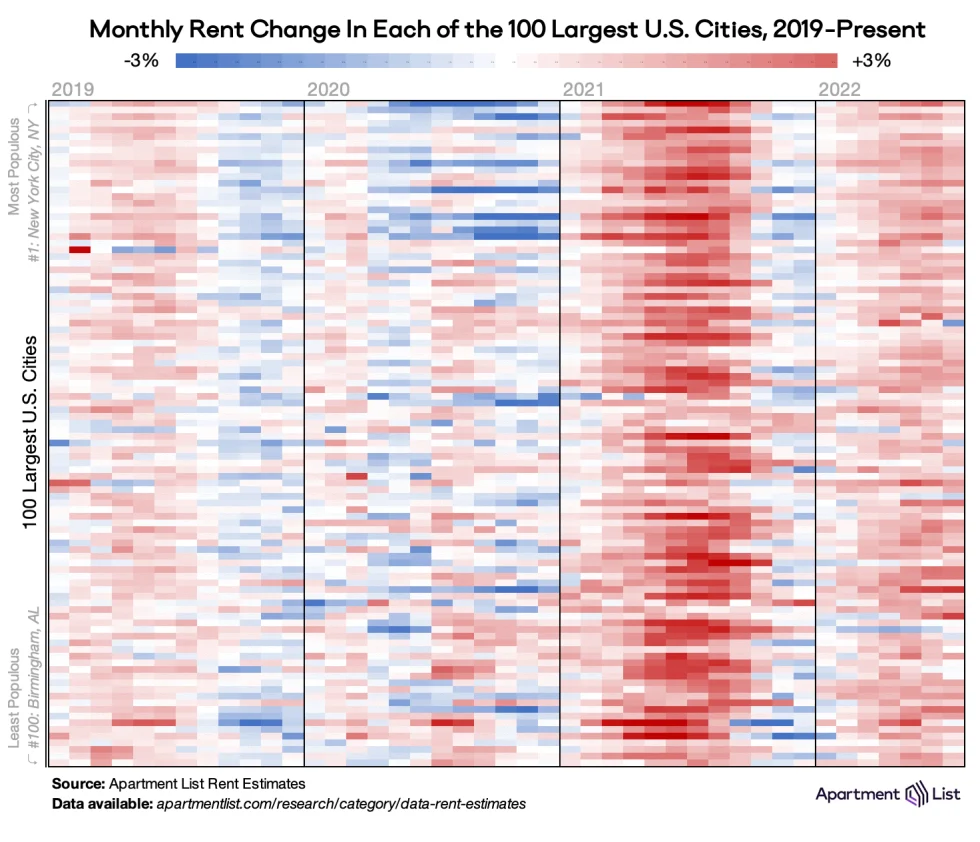
Rents increased this month in 87 of the nation’s 100 largest cities, but 80 of these cities have experienced slower rent growth in the first half of 2022 than they did over the same months of 2021. And in a small handful of these cities, rents are currently lower than they were at the start of the year. Most notably, rents in Scottsdale, AZ have fallen by 6.6 percent so far in 2022, exemplifying a broader cooldown in the Phoenix metro which we explore further below.
At the other end of the spectrum, the urban core of the New York City region has been experiencing surging rental demand. Jersey City currently has the nation’s fastest rent growth at the city-level, with prices up by 27.0 percent over the past twelve months, more than doubling the national average. Meanwhile, NYC-proper ranks number four with a year-over-year rent increase of 21.2 percent. The city’s surging rents have more than made up for early-pandemic discounts – despite falling by 20 percent from March through December of 2020, the median rent in NYC is now 17 percent higher than its March 2020 level.
Pricey coastal metros seeing prices rise again
Major markets throughout the Sun Belt have experienced virtually-uninterrupted rent growth since the start of the pandemic, but over the past six months, some of the fastest growth has been occurring in pricey coastal markets. The following table shows the ten metropolitan areas that have experienced the fastest rent growth over the past six months, over the past year, and since the pandemic started in March 2020:
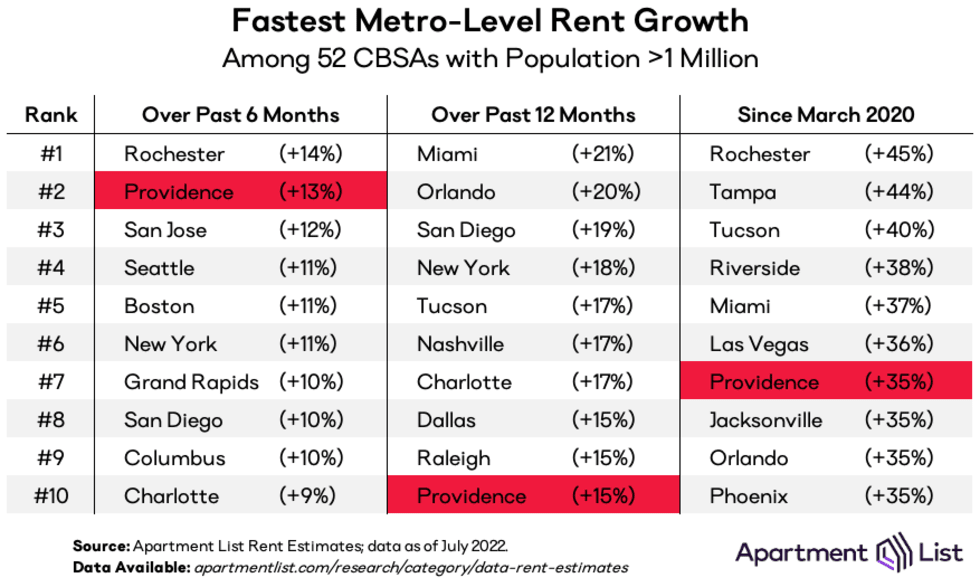
The rightmost column shows that most of the markets that have experienced the fastest growth over the course of the pandemic are primarily located in the Sun Belt, with Florida and Arizona accounting for six of the top ten. That said, Rochester, NY ranks number one for pandemic-era rent growth, with rents there up by a staggering 45 percent since March 2020. Rochester took over the top spot this month from Tampa, where growth has cooled down in recent months. Rents in Tampa have risen by 5.9 percent since January, which is actually slightly slower than the national average. As we see below, other fast-growing metros have experienced even sharper cooldowns in recent months.
On the other hand, the six-month column shows that some of the nation’s most expensive markets – which had seen sharp declines at the start of the pandemic – are now heating up again. The San Jose, Seattle, Boston, and New York metros all rank among the top ten here, and are continuing strong rebounds. Meanswhile, Providence, RI is the only market that appears in all three columns of the table above. As hybrid remote work continues to take hold, more affordable mid-sized markets such as these may emerge as attractive alternatives for those who only need to commute occasionally.
Rents in the San Francisco metro are finally back to pre-pandemic rent levels
The San Francisco metro experienced the sharpest rent declines in the first year of the pandemic, and has been the slowest market to recover in the time since then. This month however, the median rent in the area has finally risen back to its March 2020 level (at least if we round to the nearest percentage point, technically prices are still 0.3 percent below the pre-pandemic level). Note that at the city-level, San Francisco rents have yet to fully recover, and are still down 9 percent since the start of the pandemic.
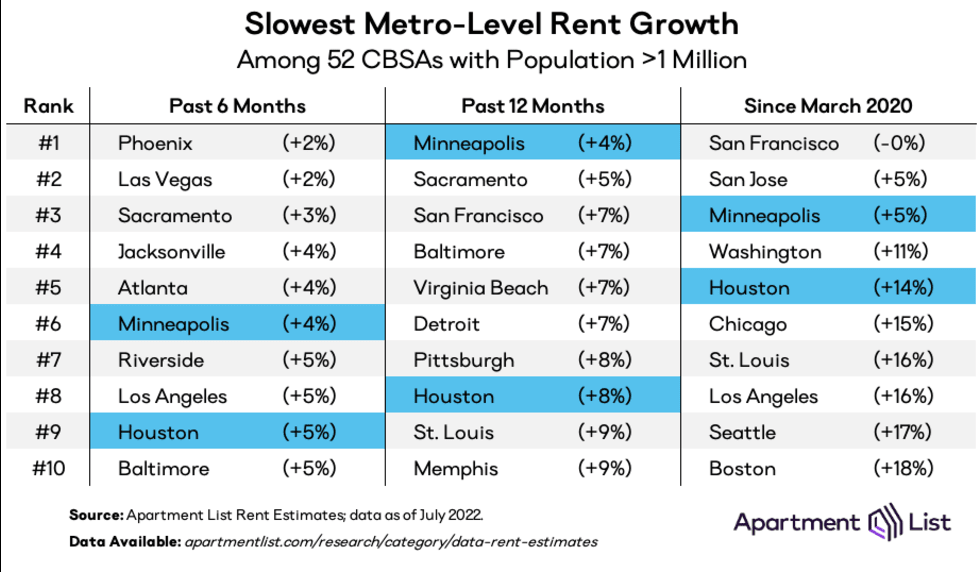
Beyond San Francisco the rightmost column of the table below is largely populated by other pricey coastal metros, including San Jose; Washington, D.C.; Los Angeles; Seattle; and Boston. Even as many of these markets have been heating up recently, they have still had among the most modest rent growth over the course of the pandemic as a whole. That said, just three metros have experienced rent growth of less than 10 percent over the past two and a half years.
Notably, the table above also shows that some of the markets that had been booming fastest are now showing signs of cooling off. For example, the Phoenix metro has experienced the slowest rent growth over the past six months, with an increase of just 2 percent, despite ranking number ten for fastest growth since March 2020. Similarly, the Las Vegas and Jacksonville metros rank among the top ten for fastest pandemic-era rent growth, but have both seen among the slowest growth in the first half of this year. After booming consistently for two years, these markets are finally beginning to plateau. Minneapolis and Houston are the only two metros to appear in all three columns of the table above, with consistently sluggish growth throughout the pandemic.
Conclusion
With a 1.1 percent increase in July, rent growth is continuing to pace ahead of pre-pandemic trends, even as it cools substantially from last summer’s peak. While the apartment market has shown some signs of easing, our 5 percent vacancy index remains well below the pre-pandemic norm, and increased pressure in the for-sale market could translate to the rental market as well. That said, this month’s slowdown in the pace of rent growth signals that the market is following its typical seasonal trend. As we enter the fall and winter months, rental activity tends to slow, and we are likely to see rent growth continue to cool. However, there are no signs that prices will actually fall in a meaningful way, meaning that American renters will continue to be burdened by historically high housing costs.
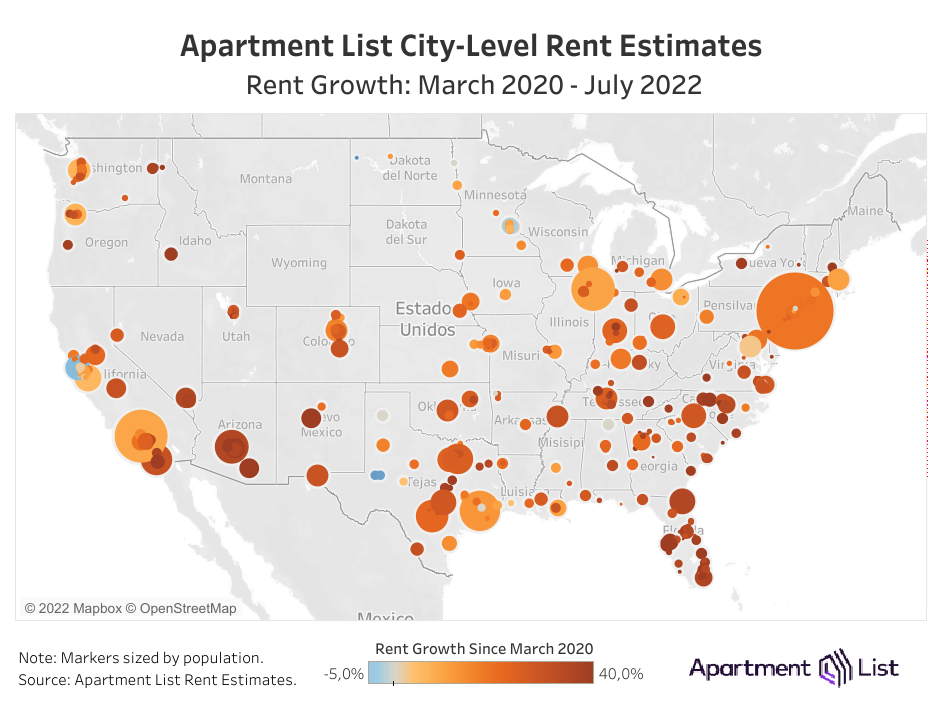
To learn more about the data behind this article and what Apartment List has to offer, visit https://www.apartmentlist.com/.







Sign up to receive our stories in your inbox.
Data is changing the speed of business. Investors, Corporations, and Governments are buying new, differentiated data to gain visibility make better decisions. Don't fall behind. Let us help.













Sign up to receive our stories in your inbox.
Data is changing the speed of business. Investors, Corporations, and Governments are buying new, differentiated data to gain visibility make better decisions. Don't fall behind. Let us help.





